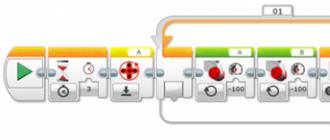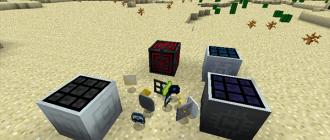The IMG extension uses image files that were created from magnetic or optical disc. Since the primary image is composed of source binary code sector by sector, the actual format of the file's contents will depend on the file system on the disk from which the image was created (for example, the FAT version). Optical disc images (such as CDs and DVDs) contain images of all the tracks on the disc (which may include audio and video tracks). In the case of such media, these images usually include not only the data from each sector, but also control the field headers and error correction for each sector. All this is important, since the question often arises of how to open the IMG format.
Features of these files
However, IMG format files do not contain additional data regarding the contents of the disk and can only be processed by programs that can detect their file system. For example, a typical floppy disk image starts with a FAT boot sector, which can be used to identify its file system. images optical discs are usually accompanied by a descriptor that describes the structure of the disc, and includes information about the contents of each track.
Where are they used and what are the varieties
Speaking about the IMG format, how to open it, you should understand what these files are and what types of them are used. The .IMG extension was originally used only for floppy disk images, but these days it is also used for hard drives. A similar file extension, .IMA, is also used to refer to floppy and disk images by some programs. Another variant of the IMG format - IMZ - is a compressed version of the disk image. Such files are commonly found in compressed floppy disk images created by WinImage.
Structure

CloneCD saves optical images discs in .IMG files and generates additional .CCD control files for each image containing the necessary metadata. The size of such a file is always a multiple of the sector size. For diskettes and hard drives their size is typically 512 bytes (sizes 128 and 1024 are also used). Optical disc images typically use the .ISO extension, however .IMG is also used. Each such file contains only one track of computer data received from the optical disc. They cannot contain multiple tracks, as well as audio or video tracks, which is why the problem sometimes arises - how to open IMG. Their internal format follows the structure of the optical disc file system, and is typically ISO 9660 (for CDs) or UDF (for DVDs).
How to open these files

Speaking about how to open IMG, we can cite several tools as an example. RAWRITE and WinImage use the IMG disk image format to read and write floppy disk images. ImDisk can create such a floppy disk image to emulate a floppy drive in Microsoft Windows. Nero Burning ROM is also good option in the question of how to open IMG - this program supports reading such files to create bootable CDs. Mtools provides the ability to manage floppy disk images created in MS-DOS on Unix systems. Also, speaking about how to open IMG, you can recall programs such as Dsktrans from LibDsk, which are a set of tools command line(only for Linux, MS-DOS and Microsoft Windows). Such applications will convert between different disk image formats.
How to open this format in Linux
Talking about what to open IMG file in Linux, one immediately comes to mind is a DD, designed to create an image of a floppy disk. In addition, the Qemu IMG application uses files of this format by default for hard drive images. Win32 Disk Imager, in turn, can read and write USB disk images in this format.
Img is the path to uncertainty. This file extension is widely used for various (raw) file formats. It's short for "image" and it can be any image you can imagine - or can't imagine at all because you've never heard of it.
For example, .IMG used to be a GEM bitmap file. Does anyone even remember GEM? It was a Windows competitor from Digital Research. The Atari ST version was widely used, but there was also a DOS version of the GOS. One stripped-down version (which was necessary to avoid Apple's copyright claims) was ViewMAX, included with DR DOS 3.41, 5.0, and 6.0, as well as Novell DOS 7.0. Now he's open source code and can be freely downloaded as OpenGEM. Still requires DOS and is included in the FreeDOS distribution. To view bitmaps GEM programs Windows addition time (based on DOS on Windows base 3.0) such as Ventura Publisher could open and therefore convert such "GEM images" or "Atari ST images" to other more widely used formats.
But I doubt this kind of .img -file is what you meant. However, you need to be more specific.
The most widely used .img is as a raw file system image, such as a floppy disk. As already mentioned, such images can be opened by a number of programs. Or directly mounted under Unix-like systems such as BSD and Linux. 7-Zip can also extract files from such images for supported file systems, such as FAT. At least the command line version. Just type 7z x image.img and it will extract the included files.
Note, however, that there are other image formats, such as IBM .dsk , sometimes using other file extensions. Such files may be raw floppy disk images, but they may also be in the IBM SAVEDSKF/LOADDSKF format. These files are basically zero-delimited raw files, but with a header at the beginning of the files. I doubt that 7-Zip can extract such images, even if it would only be necessary to find the appropriate offset. Anyway, since the image after the header is basically raw and uncompressed, with dd you can extract the image and make it the raw .img of the floppy. Suppose the header has a hex size: 291 bytes (which you should find out by looking inside the file, for example using a hex editor). This equates to 657 bytes to skip, resulting in dd if=image.dsk of=rawimage.img bs=1 skip=657 . However, the resulting rawimage.img file will be non-standard in size. This can be fixed by using dd again. dd if=/der/zero of=rawimage.img count=0 bs=1 seek=1474560 - this will produce a sparse file, resulting in the correct file size for the 1.44 MB floppy image and returning zeros in unused positions, Works with most programs under Linux.
But in general, .img can be any file that is classified as an "image", so any application can include a (native) file with that extension. Such files can only be used (opened) by the specified application.
Sometimes, during the next audit for junk files your computer, you may come across extension files that you have never worked with before. Most often, these are quite rare formats used for specific tasks. For example, an IMG file. If you have no idea what and how to open it, and why these files are needed at all, you have come to the right address. After all, of course, you can try to clarify the information from your closest acquaintances and friends, but even if there are experienced users among them, not every one of them will be able to tell exactly what kind of extension it is. In addition, it is always more interesting to understand the issue yourself. And our article will help you with this - it is devoted to how and with what to open an IMG file, what kind of format it is and what it is used for. And, of course, what program to open the img file, because it is for this purpose that everything is started. First of all, let's deal with general questions regarding the IMG extension.
What is the IMG format for?
Although many users will think that this is a picture or image file by writing the format abbreviation, in reality everything is somewhat more complicated. For many more or less experienced users, the abbreviation “img” is associated with the word “image”. And in this case, the IMG file represents a disk image. You can draw a parallel with some other commonly used disk image extensions - . But in the case of IMG, the image read-write algorithms were slightly modified.
However, you can try to change the extension from IMG to ISO - in some cases, you can open it this way desired file using a program that does not support the format.
Some time ago, the format was also widely demanded in the context of the Apple Macintosh environment. Later, in Mac OS X IMG, the format was changed to , which one of our reviews was devoted to. It can also be encountered quite often in applications. For these two environments, there are some differences in use - for Mac file The .IMG extension can be either a CD/DVD image or an HDD image. In MS Windows, the format was used only for emulation purposes. optical media. One of the programs that can create such images under Windows is CloneCD, while the resulting file will be supplemented with two additional utility files - with the extensions .ccd, .sub and the same names.
IMG as hardware firmware file
The IMG format is also used by many manufacturers of various hardware to distribute firmware updates. If your IMG file is small and you have reason to believe that it is not a floppy disk image, then this is the case. At the same time, information on how to open the IMG firmware file for each specific case should be sought on the official website of the equipment manufacturer.
When updating IMG hardware firmware, you should strictly adhere to official instructions manufacturer - in the worst case, if they are not observed, you will have to go to the after-sales service. Therefore, you should not trust the instructions for hardware firmware on third-party sites.
What programs to open IMG exist
Finally, let's move on to the main part of our review - let's choose which program to open the IMG file with minimal difficulties. How does this format work in general? There are two options, as in the case of other disk images:
- Burn the image to a CD/DVD and then read it on a regular drive.
- Use one of the virtual drive emulators below.
Let's consider the second option in more detail. In order to open an IMG file, you can use the following programs:
- Nero Burning ROM - known to many software, most often used to work with images of another format - .nrg. There is no free version, you need to purchase a license;
- Daemon Tools Lite - free lite version can be used to open IMG;
- UltraISO - there should be no problems with finding and downloading the utility. The program is easy to install on a computer, but without buying a license it can only work with files less than 200MB. Using this utility, you can not only open an img file on a virtual drive, but also burn a CD / DVD (subject to the limitations mentioned).

Now you know exactly how and with what to open img on a computer. We hope that the information provided was useful and that in the future, working with this format will not cause you any difficulties.
If you suddenly found an img file unknown to you on your favorite computer (for example, you copied it from a friend’s flash drive or downloaded it from the Internet), but you don’t know how to open it, don’t be scared or upset. Of course, you can try to find out from a friend than to open img, however, firstly, it is far from always possible to find a knowledgeable friend, and secondly, it is better to try to figure it out yourself. And this article will help you in this difficult matter, because it is devoted specifically to the question of how to open the img file.
If there is an img file in the folder in front of you, which you have no idea how to open, the first thing to do is figure out what kind of format it is.
Img, contrary to the opinion of many users, is not an image or a picture at all. Of course, for many, img is associated with image, but in this case the word is translated as “image”. That is, the IMG file is a disk image, a kind of analogue of ISO, only with slightly different algorithms for reading and, accordingly, writing the image. It should be noted that often a simple change in the img file extension to iso makes it possible to open files in those programs where img formats are not supported.
This format was widely used to create a disk image in the Macintosh environment, but is also quite common in Windows applications.
In Mac OS X, the .img format has been replaced by the .dmg extension. And if in Mac OS this format can be both image and image hard drive, then in Windows it is used only for emulating CD / DVD media. Usually in the OS Windows files of this format are created by the CloneCD program. And the full image will be supplemented with .ccd and .sub files with the same names.
But still, we will try to directly answer the question of how to open img. by the most popular programs to work with this format are NERO, Daemon Tools and UltraISO.
First, let's figure out how to work with files. this format. As with any other disk images, you can emulate img in a virtual drive on your computer. In addition, the image can be recorded on a real laser disc and then use it in a normal drive.
UltraISO Disk Image Program
To download the distributor of this program to your computer, just type its name in any search engine and follow the link provided. This program Installed and works quite simply. Install the UltraISO program on your computer, following all the prompts, then restart the computer. Everything is ready to go. To simply solve the problem than to open img, you do not need to open the program at all. It is enough just to find the disk image of this format in the folder, right-click on it and thereby call it. In the menu, select the line "UltraIso", where in the drop-down menu select the appropriate type of action. You can immediately mount the disk image to a virtual DVD drive or burn the image to a real disk.
To burn an image to a disc, you must insert an empty disc into the drive and click on "burn". Just be sure to check if your DVD-ROM or CD-ROM is a writer. If the device does not have such a function, then, accordingly, you will not be able to burn the image to disk. But do not despair, because you will still be able to run the disk in the virtual drive. UltraIso program will help you not only open an img file, but also burn it to a real disk - easily and universally!
Work with NERO programs and Daemon Tools we will not consider, since these programs will require you to purchase a license. And the free versions are not very convenient.
Now you know how to open img on a computer. I hope that more files this format will not cause you any inconvenience. If you also have iso images on your computer, they open in the same way.
Today, many users are faced with new file formats that they could not work with before. It is perfectly normal that the quite expected question arises: with which program to open the file? In this article, we will focus on IMG files in more detail.
Before we can understand what program can open an IMG file, we need to understand what is given file and what information it may contain.
What is an IMG file?
You probably know about disk image files. Such files contain accurate information taken from physical disk, allowing, for example, how to burn an image to a new disc, and run it on a computer without a physical drive (you only need a program that will allow you to emulate a virtual CD drive).
An IMG file is an image of a disk, whether hard or optical. Not the most popular image format, like ISO, for example, but you can still see it from time to time.
How to open an IMG file?
From the foregoing, we can conclude that an IMG format file can be opened using almost any program that will allow you to create virtual drive, i.e. you will need to reproduce the disc image on your computer.
1. Ultr ISO. A popular combine that many users are familiar with. This program supports all disc image formats, including IMG. Need universal program to run, burn, create and edit disc images? Then turn your attention to UltraISO.

2. Daemon Tools Lite. If you need to run the IMG file on your computer, then it will be enough for you free version famous program to work with images. With it, you can create a virtual drive, and then run the IMG image through it.

3. Alcohol 52%. Next free tool, which will become an effective assistant in mounting disk images. The program works with most image formats, has enough simple interface and does not give a serious load on the system, and therefore it is also perfect for working with the IMG format.

All three programs listed in the article are guaranteed to open an IMG file.






